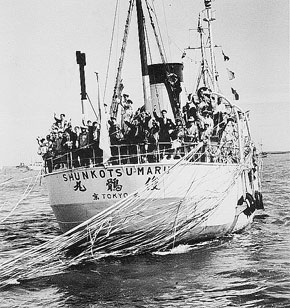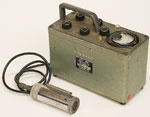 |
| Hydrogen test and Japanese scientists | |||
| In response to the damage and contamination caused by radiation from nuclear tests, Japanese scientists analyzed the "ashes of death" and tested ocean water and radioactive rain. Tokyo University and four other universities analyzed "ashes of death" and detected 20 kinds of fission products (radioactive nuclides). In May 1954, the Ministry of Agriculture, Forestry, and Fisheries, Fisheries Agency sent the oceanographic inspection boat Shunkotsu Maru to the Bikini Islands to measure radiation in ocean water, air, the atmosphere, and ocean currents. Their radioactivity measurements in the Bikini sea area were far higher than expected. All plankton and tuna they sampled within a 150 km radius of the Bikini Islands were found to be significantly contaminated. These results raised fears that radioactive material would concentrate in living organisms and that hydrogen bomb testing would cause global-scale contamination. |
 6/The Shunkotsu Maru leaving Tokyo Harbor |
||
 7/A Geiger counter used to measure radiation |
|||
| Third Radiation Exposure - The Lucky Dragon No. 5 and Hiroshima Encounter with a hydrogen bomb test Lucky Dragon No. 5 "A-bomb tuna" and radioactive rain Hydrogen test and Japanese scientists Voices opposing A- and H- bombs Damage to the Marshall Islands from nuclear tests Preservation of the Lucky Dragon No. 5 and construction of an exhibition hall The Lucky Dragon No. 5 and Hiroshima Conclusion Tokyo Metropolitan Daigo Fukuryu Maru Exhibition Hall Return to TOP |